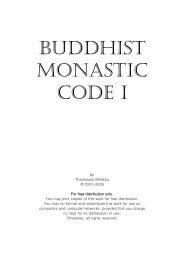Vipassana Kammatthana.pdf
Vipassana Kammatthana.pdf
Vipassana Kammatthana.pdf
Create successful ePaper yourself
Turn your PDF publications into a flip-book with our unique Google optimized e-Paper software.
of attachment on craving (taˆhå nikanti) which hold the sa∫khåradhamma as "mine, mine ".<br />
Only if there is sukhasaññå (perception of enjoyment on sa∫khåradhamma),<br />
the taˆhågåha = taˆhå view which hold the sa∫khåradhamma<br />
as "mine, mine" can arise. Dukkhånupassanå insight is directly opposite to taˆhå vie<br />
w, attachment. Therefore dukkhånupassanå<br />
insight can cause the cessation of taˆhå view. (Vism xx §721 & Mahå ¥kå. II. 415-<br />
416)<br />
Therefore after having meditated on the three characteristics thoroughly, then give priority t<br />
o meditating on one of the characteristics which one prefers for a rather longtime. If that anupassanå<br />
insight is not powerful, then meditate again on the other two characteristics. However<br />
kilesa are removed by vipassanå insight temporarily only. Only ariyamaggañåˆa can eradicat<br />
e totally without remainder by samuccheda. To attain ariyamagga one must strive for the mat<br />
urity of vipassanå insight.<br />
ADDHÓPACCUPPANNA<br />
Among the nåma-rËpa which have already arose, are arising and will arise within one whole l<br />
ife from pa isandhi to cuti, meditate vipassanå again and again for many times thoroughly on:<br />
1. the three characteristics of just rËpa only alternately<br />
2. the three characteristics of just nåma only alternately.<br />
It is necessary to meditate for many times by every anupassanå. Meditate one round on inte<br />
rnal, one round on external, one round on anicca, one round on dukkha, one round on anatta f<br />
or many times, again and again.<br />
FIVE KHANDHÓ METHOD<br />
The meditator should again discern the nåma according to åyatanadvåra, especially as in th<br />
e nåma kamma håna tables again. Firstly again discern the cakkudvårav¥thi and manodvårav¥<br />
thi where somanassasahagata<br />
ñåˆasampayutta mahåkusala javana arise. After having formed the rËpadhamm<br />
a as one group and the nåmadhamma as four group which exit in each mind moment such as:<br />
1. the basis vatthurËpa (54) and rËpårammaˆa are rËpakkhandhå<br />
2. vedanå in each (moment) is vedanåkkhandhå<br />
3. saññå in each is saññåkkhandhå<br />
4. the remaining cetasika sa∫khåradhamma in each are sa∫khårakkhandhå<br />
5. consciousness in each is viññåˆakhandhå,<br />
meditate vipassanå on them. Meditate on their three characteristics alternately.<br />
Meditate vipassanå similary on each of the following v¥thi by five khandha method:<br />
1. the remaining cakkhudvårav¥thi and manodvårav¥thi which take rËparammaˆa as object<br />
2. sotadvårav¥thi and manodvårav¥thi which take saddårammaˆa as object<br />
3. ghånadvårav¥thi and manodvårav¥thi which take gandhårammaˆa as object<br />
4. jivhådvårav¥thi and manomdvårav¥thi which take rassårammaˆa as object<br />
5 kåyadvårav¥thi and manodvårav¥thi which take pho habbårammaˆa as object<br />
6. manodvårav¥thi which take dhammmårammaˆa as object.<br />
From pañcadvåråvajjana until manodvårav¥thi's tadårammaˆa in every line, as shown in nå<br />
ma kamma håna tables, meditate vipassanå on the three characteristics alternately of:<br />
1. Just rËpa only throughout the line<br />
2. Just vedanå only throughout the line<br />
3. Just saññå only throughout the line<br />
4. Just cetasika sa∫khåra only throughout the line<br />
5. Just viññåˆa only throughout the line.<br />
17






